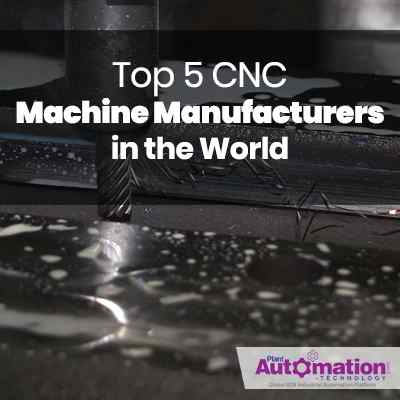Introduction to CNC Machining | Top 5 CNC Machine Manufacturers in the World

Introduction to CNC Machining:
CNC (Computer Numerical Control) Machining process is extensively used in the manufacturing sector as it helps to control machine tools using computers. In this manufacturing process (CNC Machining), the movement of tools is controlled using pre-programmed computer software.
Machine tools that can be controlled using this process are lathes, routers, mills, and grinders. Live operators need to prompt and guide the commands of machining tools via levers, wheels, and buttons.
There are two types of CNC Machining systems. They are a) Milling b) Turning
Each CNC Machining system is suited for manufacturing different geometrics.
CNC Milling: It is most popular CNC machine system. In CNC milling, the part is mounted onto the wood/floor and material is removed using rotational cutting tools.
• CNC Milling Machine performs vertical operations.
• Here, JOB will move and TOOL will rotate.
• It can be called as MACHINING CENTRE.
Note: Here, JOB means the material which we want to make required shape and size.
| Also Read: How SEO Can Drive Business Growth for CNC Manufacturers? |
"TOOL" is simply a tool
CNC Turning: In CNC turning systems (also known as lathes), the part is mounted on a rotating chuck and material is removed using stationary cutting tools. Turned parts are typically produced faster (and at lower cost) than milled parts. These systems are mostly used to create parts with cylindrical profiles.
• CNC Lathe Machine performs horizontal operations.
• In this process, JOB will rotate and TOOL will move.
• It can be called as TURNING CENTRE.
Understanding the main parts of the CNC Machine:
The main parts of the CNC machine are:
a) Input Devices: Input devices help to input the part program(sequence of instructions that describe the work to be done on a part) in the CNC Machine.
b) Machine Control Unit (MCU): Machine Control Unit (MCU) performs all the controlling action of the CNC Machine. It performs various functions such as:
• Reading the coded instructions that are provided to it
• Decodes the coded instruction
• Implements interpolation ( linear, circular and helical ) to generate axis motion commands.
• Receives the feedback signals of position and speed for each drive axis
• Implements the auxiliary control functions such as coolant or spindle on/off and tool change
c) Machine Tool: Having a slide table and a spindle to control, machine tools control the position and speed of the machine. The machine table is controlled in X and Y axis direction and the spindle is controlled in the Z axis direction.
d) Driving System: The driving system includes amplifier circuits, drive motors and ball lead screw. This system is responsible to rotate the ball lead screw to position the machine table.
e) Feedback System: The Feedback system consists of transducers that acts like sensors. It is also called as measuring system. The system is also included with position and speed transducers to monitor the position and speed of the cutting tool located at any instant.
f) Display Unit: Display unit is used to display the programs, commands, and other useful data of CNC machine.
| Also Read: Advancements in CNC Machining Technology in Metal Cutting Processes |
Working of CNC Machine:
1) Initially, the part program is inserted into the MCU of the CNC machine.
2) According to the program prepared, all the data will be processed in Machine Control Unit (MCU). And, it prepares all the motion commands and sends it to the driving system.
3) As MCU sends the motion commands, the drive system starts working. It also controls the motion and velocity of the machine tool.
4) Feedback system records the position and velocity measurement of the machine tool and sends a feedback signal to the MCU.
5) In MCU, the feedback signals are compared with the reference signals.
If any error occurs, MCU corrects and sends new signals to the machine tool for the right operation to process.
6) Display unit displays all these executed programs, commands, and other important data.
|
Also Read: An Overview of the European CNC Machine Industry: Top 5 Manufacturers to Watch in 2023 |
CNC Coding:
Basically, CNC coding will be in the Machine Level languages. Based on the requirement, coding will be changed for the functioning and operation of the CNC.
The function of the CNC machine can be classified broadly as follows:
• Auxiliary Function (M-CODE)
• Preparatory or Main Function (G-Code)
• Spindle Speed Functions (S-Code)
• Feed Function (F-Code)
• Tool Function (T-Code)
M-code
As the name indicates, the auxiliary function is subordinate actions in the CNC machine. It is also called as the M-CODE
Some of the examples of this function are:
• Spindle ON or OFF
• Door Opening
• Coolant Operation
Some of the Common M codes in all the CNC machine are as follows :
• M03- Spindle ON clockwise
• M04-Spindle ON counterclockwise
• M05- spindle OFF
• M07 or M08- Coolant ON
• M09- Coolant OFF
• M30- Program end/ reset/ rewind
NOTE: Here spindle refers to part which holds the JOB. The Spindly may be connected to the Induction or any other Motors, which makes it rotate.
G-code
G-code is a programming language for CNC and it instructs machines, where and how to move. Codes may vary depending on type, making, and model.
Sample:
G-code stands for “geometric code,” and follows some variation of the alpha numeric pattern:
N## G## X## Y## Z## F## S## T## M##
• N: Line number
• G: Motion
• X: Horizontal position | Y: Vertical position
• Z: Depth
• F: Feed rate
• S: Spindle speed
• T: Tool selection
• M: Miscellaneous functions
• I and J: Incremental center of an arc
• R: Radius of an arc
For example,
G01 X1 Y1 F20 T01 M03 S500
It would generally indicate a linear feed move (G01) to the given XY position at feed rate of 20. It is using Tool 1 (T01), and the spindle speed is 500. M03- Spindle ON clockwises
S-code
S-code focuses on the Speed of the Spindle. As we cannot set the rotation speed of spindle to any arbitrary value, there is a calculation for the proper speed setup. If the proper speed is not maintained, it may lead to the improper 'Finish' of the JOB.
Speed of the Spindle = S(rpm value)
Note: We need to find out RPM value.
The speed of the Spindle mainly depends on the 2 main factors as follows :
• Diameter of the Tool or Job
• Cutting Speed (i.e. the Metal Removal rate)
CUTTING SPEED Vc= {(Circumference of the material or length removed per rev)*(number of revolution)}/ 1min
Vc= π* D*n/1 mm/min
Vc =π* D*n/1000 m/min
now Rotation per min RPM n= (Vc*1000)/π* D
RPM can be calculated easily.
EXAMPLE:
Consider an example of the material to be removed is of the diameter 100mm, cutting speed is 200 m/min
Ans:
Given D=100mm
Vc=200m/min
RPM (n)=(Vc*1000)/π* D π =3.141(default)
RPM (n)=(200*1000)/(3.141*100)
n=636 RPM to be set for the good machining process.
CODE:
S(rpm value)
Example S636 ---> this maintains the speed of the Spindle at that RPM.
F-code
F-code deals with the movement of the Tool for the required output shape.
It can be coded in two methods as follows :
F (speed in mm/min)
For example: To set the speed of the tool as 100 mm/min; we write as F100
F(mm/revolution)
For example: To remove 100 mm material in 1 min then we write as F100
T-Code
This function determines the appropriate tool for the correct operation of the JOB.
There will be set of Standard tools listed in the CNC and feed will change the required tool automatically.
The tool Code syntax can be written as follows:
T (tool number )(Offset Number)
Example:
T0101---->here the first 01 determines the tool number and the next 01 determines the offset number of the tool
Advantages of CNC Machining:
+ CNC machining offers excellent accuracy and repeatability, and using this method, parts can be produced with very tight tolerances, making it ideal for high-end applications.
+ CNC Machining is the most cost-effective manufacturing process for the producing low-to-medium numbers of metal parts.
+ Operators can easily make changes and improvements and reduce the delay time
+ CNC Machining enables to produce complex design with high accuracy in minimum possible time.
+ The modern design software, allows the designer to simulate the manufacturer idea. And, this removes the need of making a prototype or model , saving time and money.
+ Fewer workers are required to operate a CNC machine and saves labor cost.
Disadvantages
Despite of having so many advantages, a CNC machine has some disadvantages. And these are:
- Certain geometries of CNC machining are either very costly or impossible to manufacture.
- The start-up cost of CNC machining is high compared to 3D printing, so CNC is less suited for low-cost prototyping (especially for plastics).
- The cost of the CNC machine is very high as compared with manually operated machine.
CNC Machining - Market Overview
The Computer Numerical Control (CNC) machine market size was valued at USD 56.04 billion in 2016 and is estimated to spur the growth over the forecast period.
According to a new report by Grand View Research, Inc, the global CNC Machines market size is anticipated to reach USD 100.9 billion by 2025, rising at a CAGR of 6.8% owing to increased efficiency, reduction in cycle time, and reduced wastage.
Technological advancements are the driving force to use CNC Machining in the development of highly intricate components/models with a definitive finish. This has subsequently led to a rise in implementation of CNC technology in lathe, milling, laser, grinding, and welding machines.
Top 5 CNC Machine Manufacturers in the World
1) Breton S.p.A - Breton S.p.A provides the high speed numerical control machining centers, and it is one of the most important CNC manufacturers in the world.
Breton's machining centres are well-known to their top technological level, superior production performances, groundbreaking solutions and undisputed quality of the product/service system offered to its customers. Breton developed a full range of machining centres, that satisfy all the requirements of the following industrial sectors: Aerospace, Defence, Aeronautics, Automotive, Naval, Motor Racing, Gears, Energy, Die, Automotive and Naval Modeling and Prototyping, General Manufacturing Industry.
2) KNUTH Machine Tools
KNUTH Machine Tools is a worldwide leading supplier of machine tools and accessories. KNUTH Machine Tools provides the right tool for your requirements. The company places the same emphasis on reliable quality as on low maintenance and simple operation.
3) Laguna Tools Inc.
Laguna Tools is an award winning manufacturer of CNC Routers, CNC machinery and tools for industrial sectors. The company is the manufacturer of CNC machinery for woodworking Industries.
4) LYWENTECH CO., LTD
Lymo is the Number One Manufacturing and supplying partner to dealers of CNC machine tools around the world. The company provides CNC machines in the sourcing of machine tool solutions for every application.
5) Hasil Karya Sdn Bhd
Hasil Karya is one of the leading industrial machinery and tools distributors in Malaysia, particular in Aluminium, Machine Tools and Sheet metal industry. Its wide range of product distribution includes Drilling machines, Punching Machines, Laser Cutting machinery, Water Jet Cutting, Bending machines, Milling machines, Rolling machines, and shearing machines.











